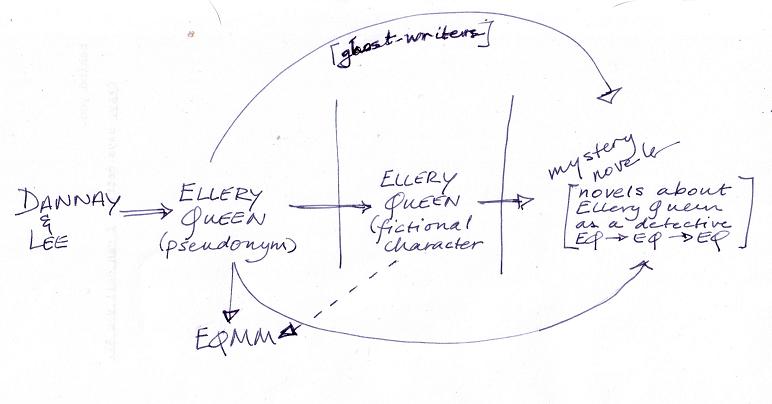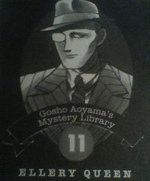The lovely people at Tor.com have agreed to let me play in their sandbox, but I thought before I start building castles, it would be polite to introduce myself, and, in progression, Ellery Queen.
I’m Sarah Monette. I’ve been on LiveJournal for *mumblecough* years as truepenny. I write fantasy, horror, and (rarely) science fiction. My first four novels (Melusine, The Virtu, The Mirador, Corambis) were published by Ace Books, and a collection of horror short stories, The Bone Key, was published by Prime in 2007. I’ll have a second collection of mixed-genre short stories, Somewhere Beneath Those Waves, out from Prime in 2011. For Tor, I’ve co-written one book, A Companion to Wolves, with Elizabeth Bear. (The sequel, The Tempering of Men, will be out in 2011.) I’ll have another novel out from Tor in 2012, The Goblin Emperor, under the pseudonym Katherine Addison.
I also have a Ph.D. in English literature. My specialty is Renaissance drama, specifically Jacobean revenge tragedy (and if you’re interested in my dissertation, I put it online here). I did a generalist Master’s degree (everything from Beowulf to Toni Morrison) and I’ve taught for courses in nineteenth century British literature and twentieth century American literature, amongst a rather bewildering host of other things.
Which is all to say that both my professional hats are about analyzing the snot out of stories.
That’s the techincal term.
If you want to see what my non-academic critical analyses look like, I’ve done several series on my blog: Dorothy L. Sayers’ Peter Wimsey books, C. S. Lewis’ Chronicles of Narnia, the television show Due South (ongoing). For Tor.com, along with reviewing new releases, I suggested that I start by writing a series of posts on Ellery Queen. The lovely people at Tor.com were amenable.
Which means that, having introduced you to myself, I need to introduce you to Ellery Queen.
* * *
 As Dorothy Parker said in Esquire in 1959, Ellery Queen is:
As Dorothy Parker said in Esquire in 1959, Ellery Queen is:
“an author somewhat difficult to explain. Ellery Queen is two men. Or perhaps it is better to say that two men are Ellery Queen—no, that doesn’t look right, either. Well, anyway, it seems there are two gentlemen named, respectively, Frederic Dannay and Manfred Lee, who banded together to write as one, signing their products as Ellery Queen. Then, possibly to make shorter the way on which lies madness, they named their crack brain-child, the hero of their many tales, Ellery Queen, too. So there, if you can clear your head, you are” (Quoted on the back cover of The Ellery Queen Omnibus (New York: Library of Crime Classics-International Polygonics, 1988).
The situation is actually even more complicated than that.* Frederic Dannay and Manfred Bennington Lee’s birth names were Daniel (David on the birth certificate) Nathan and Manford (Emanuel on the birth certificate) Lepofsky, so their joint pseudonym is nested inside other pseudonyms and onomastic confusion. The fiction is also maintained, at least in the first Ellery Queen books, that “Ellery Queen” is the character’s pseudonym, and the final twist in the Queenian knot is that Ellery Queen the character is a writer of detective novels. The nature of his detective novels changes over the course of the series. In the beginning, he’s supposed to be writing the stories in which he appears from the villa in Italy to which he has retired; in later novels, when the more precieux corners have been knocked off, he’s a working writer, and most of his output seems to be unrelated to his career as a detective. Eventually, as the EQ empire grew, Dannay and Lee would start hiring other writers to produce Ellery’s novels. Among those writers were Jack Vance, Avram Davidson, and Theodore Sturgeon.
So the state of play with regards to the signifier “Ellery Queen” looks like this: Ellery Queen, in other words, is a matryoshka doll of nested identities: Ellery Queen the pseudonym writes about Ellery Queen the character/author who writes about Ellery Queen the character/detective.
Ellery Queen, in other words, is a matryoshka doll of nested identities: Ellery Queen the pseudonym writes about Ellery Queen the character/author who writes about Ellery Queen the character/detective.
EQ => EQ => EQ
Q.E.D.
* * *
Peter Dickinson has a wonderful essay in Murder Ink (New York: Workman Publishing, 1977), “The Lure of the Reichenbach,” in which he talks about the difference between deliberate and accidental mystery heroes. The accidental hero, he says, “come[s] into existence because the author wants to write a particular book. The book itself demands a detective, and he grows into being, quite slowly, finding his shape and nature from the needs of the book and the author’s own needs. He may turn out a very odd creature, but all his oddnesses are expressions of what he is like inside” (67). On the other hand, deliberate heroes are those which are created because the author has decided to write a series of books and has decided that therefore they must have a trademark: “Thus, traits of difference are accumulated, selected not from the way they grow out of the character but solely because nobody else has yet thought of them. In much the same way, minor German monarchs of the eighteenth century invented uniforms for their household troops” (65). Dickinson points to Nero Wolfe and Hercule Poirot as deliberately created detectives (and of course the shadow of Sherlock Holmes looms over the whole piece), and he suggests Margery Allingham’s Campion as a transitional type, a detective who starts out deliberate and becomes, as it were, accidental, who grows from an assemblage of quirks into a character who feels like a real person. He could also have pointed to Lord Peter Wimsey. Or Ellery Queen.
My intention is to write a series of posts about Ellery Queen’s transformation from a deliberately assembled (or jumbled, as Dickinson says) detective to a three-dimensional character, and about the ways in which Ellery’s metamorphosis is reflected in the novels surrounding him. Or, to put it another way, the process by which Ellery Queen (Dannay and Lee) went from writing typical Golden Age detective fiction to writing quirky, self-interrogatory mystery novels. (And, yes, the slight failure of synonymity of the phrases “detective fiction” and “mystery novels” is deliberate.) I’ll start, in the next post, by talking about the first three Ellery Queen novels—The Roman Hat Mystery (1929), The French Powder Mystery (1930), and The Dutch Shoe Mystery (1931)—about how they construct a detective and how they construct a detective story. And in the subsequent posts, I’ll explore how both of those things evolve.
I hope you’ll come with me.
*All biographical information is taken from Ellery Queen, a website on deduction.
Sarah Monette wanted to be a writer when she grew up, and now she is.










